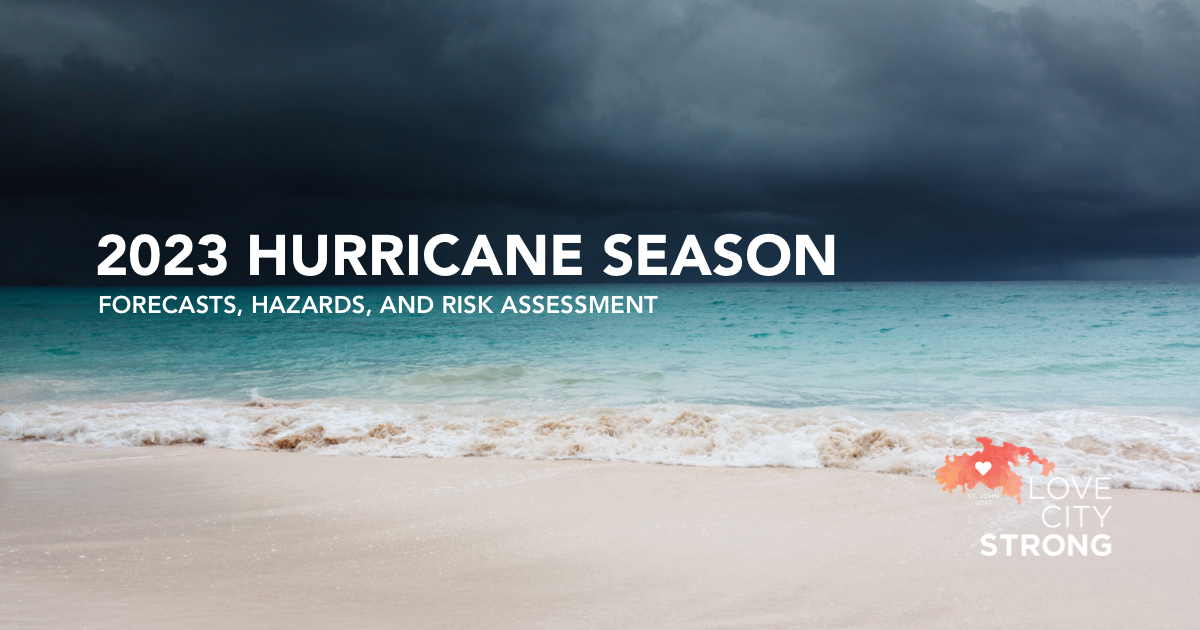
2023 Seasonal Forecast and Risk Assessments

2023 Forecast
In April, Colorado State University released their first long range forecast for the 2023 Atlantic Hurricane Season. According to the research team, this season could be slightly below average due to El Niño conditions in the Pacific Ocean. Their projections are for 13 named storms, including 6 hurricanes, 2 of which they expect to be major (Category 3 or higher) storms. These numbers are slightly below the 1991 to 2020 average per year.
You may be saying, below average? Great news! However, as we all know, it only takes one storm to create significant damage in our community. Even a below average season can produce above average damage for an island or region. In order to plan proactively and be prepared in the event of a disaster, we must each take a moment to step back and assess our risk, whether at home, at school, at work, or within our communities.
What is Risk Assessment?
The United Nations Office for Disaster Risk Reduction defines disaster risk assessment as “a qualitative or quantitative approach to determine the nature and extent of disaster risk by analyzing potential hazards and evaluating existing conditions of exposure and vulnerability that together could harm people, property, services, livelihoods, and the environment on which they depend”.
What does that mean for you?
Risk assessment on a personal level is the process of taking in all the information you have about a given threat, like a potential hurricane, along with all that you know about your home and your life, and deciding how likely it is that this hazard (the hurricane) will inflict harm. In the context of the 2023 hurricane season forecast, our first inclination might be to feel relief at the prospect of a “slow season”. However, upon examination maybe we remember that we haven’t had the trees on the property trimmed in a while, or that we never did find that one shutter for our bedroom window. Perhaps we recall that our neighbor down the street is still living in a home with a damaged roof, or that a member of our church needs to keep their insulin cold. Understanding the risk for wind damage or for extended power outages can help us to prepare for these needs.
Understanding Hazards and Forecasts
We can often become complacent about “small” hurricanes, or “just” tropical storms, but the reality is that these systems are capable of just as much damage. Just last fall, Fiona made landfall in Puerto Rico as a Category 1 storm, but dropped more than 30 inches of rain in two days, triggering catastrophic flooding across the island. We’ve all experienced tropical systems moving through the territory that seem so much more intense than expected, with gusting winds and intense periods of rain. The reality is that these weather patterns are mercurial, subject to change and constant variability. A storm that is headed our way may, to our relief, skirt to our south, and a storm we expected to pass by at a safe distance may make a strong turn and make landfall in the territory.
The best course of action is to always be prepared. Internally at Love City Strong, we generally prepare as if a storm will be two categories stronger than forecast. The same approach should be taken for rain forecasts – if we’re expected to get 2 to 4 inches, imagine what the impact would be of 6 to 8 inches, and prepare for that. Over prepared is always best.
As we count down until the start of hurricane season on June 1st, it’s important to be proactive and plan ahead. Fire up your generator, check your emergency kit, restock any necessary items. Most importantly, talk about your emergency plans with your family, your neighbors, and your colleagues. The more we normalize conversations about preparedness, the more easily we can support each other in times of crisis.
